The Burnt Toast Guide to Family Dinner
Written by a mom who is frequently doing it “wrong.”
BT Guides are a series where I dig into your most frequently asked questions. You can catch up on all the others here.
BT Guides will always be a free resource, but if you find them valuable, please consider supporting this work with a paid subscription. You can join for just $5 per month (or $50 for the year).
Or upgrade to Extra Butter (our premium tier) for $99 per year.
Extra Butters get everything that comes with the usual paid subscription plus a second Indulgence Gospel episode every month, a comp subscription to , and a monthly Live Thread with me. Our next one will be next Wednesday, March 13 at 12 Eastern.
If you can’t make it (time zones!) but have a question or an idea for a group discussion, you can drop it here and catch up on the thread later.
Should We Break Up With Family Dinner?
As I wrote in this essay last fall, I am not the right person to ask about family dinner.
I am not a dietitian, I am not a feeding therapist, I am not a food writer. I’m a good home cook who loves food, yes. I’m a parent of two cautious eaters (one with a dramatic backstory). I am a writer who has applied her journalism training to researching how and why “picky eating” happens and who thinks critically about how diet culture and patriarchy makes it worse. And I have a lot of (evidence-based) thoughts on how we can use the dinner table to foster body autonomy and push back against anti-fatness and diet culture.
But: None of this has ever meant I have perfect family dinners.
I don’t have kids who eat everything (or even most things).
I don’t have kids who want to chat about their day, or volunteer their roses and thorns.
Many nights, I don’t even have kids who want to sit in chairs.
I don’t like meal planning for the week and I flat-out refuse to spend my weekends meal prepping.
I don’t serve a vegetable every night.
I don’t make everything from scratch.
I don’t do these things because a lot of what we’ve been told we should do about family dinner only serves to increase the mental load and physical labor of the food-preparing parent (hi that’s me!). And it’s not clear from research that intensive emotional and physical labor is necessary to achieve the benefits of family dinner.
This is especially true if you dispense with the notion that family dinner should be a “childhood ob*sity prevention” strategy. Of course, as I wrote in Fat Talk, it is all too often marketed that way:
[...] the cultural value of family dinner is so often defined through its ability to prevent kids from getting fat. “Lower rates of ob*sity,” along with more coded phrases lie “healthier eating patterns” and “preventing overeating” show up on every list of family dinner benefits [...] frequently cited in morning show segments, on parenting blogs, and by other media. And studies about the link between family dinners and “ob*sity prevention” are always guaranteed a flurry of media buzz. One 2011 evidence review found that eating at least three family meals together per week was associated with a 12 percent reduction in “the odds of overweight.” A more significant finding from the paper was that family meals reduced a child’s risk for disordered eating by a full 35 percent—but the researchers’ own press release led with “family meals promote healthier weights,” and the media coverage followed suit.
This framing is dangerous because it’s misleading: Research has not established any causal relationship between family dinner participation and children’s body size. It also encourages families to use high-pressure tactics to get kids to eat more of some foods and less of others, all of which undermines the potential for family dinner to benefit kids.
I do believe that family dinner is one way to spend some quality time with our people. It gives parents a chance to model how to eat—kids need to watch someone else use a fork before they can figure it out. Sharing meals also lets us keep tabs on how our kids are eating, which is especially important in the tween and teen years when the risk of disordered eating rises. And: The way we approach any meal with our kids can help empower them to trust their bodies and find joy and comfort in food.
If those are also your big picture goals, then this guide might help you navigate some common hurdles.
1. Family dinner matters. But it’s just one option.
Here’s what I wrote in Fat Talk about the importance of family dinners:
When researchers analyze the potential of family dinners to provide a kind of refuge for kids, they document all sorts of positive associations: better vocabularies, and early literacy skills for younger kids, lower risk for developing depression, less substance abuse, and less harmful emotional consequences for teenagers who experience cyberbullying.
But we can’t overlook the role of privilege in this. It’s unlikely that eating together is in and of itself so powerful that it can prevent teen depression, and far more likely that the families who have the time and resources to make family meals a priority also have other privileges that enable them to enrich their kids’ lives and support them through rough times. In other words: If you’re able to worry a lot about getting family dinner “right,” you are likely operating from a place where your kids are already at less risk for the kinds of struggles that family dinner evangelizers claim it can solve.
This means you can release the guilt, if family dinners don’t fit into your life. Work schedules are often at odds with little kid bedtimes, or older kid extracurricular activities. Neurodivergent kids often need a less rigid approach to meals, and this doesn’t mean they or their caregivers are doing anything wrong. And I absolutely subscribe to the wisdom of
, who says that family dinner doesn’t need to happen before age 3. (And she has written whole books in favor of family dinner! Is a very big fan!)If you don’t eat dinner together, you can get all those “family dinner” benefits from another shared meal, or even from any shared time that has absolutely nothing to do with food. Think: Car rides (lack of eye contact can be helpful!), bedtime, and other low-stakes activities where part of your brain isn’t also parsing their eating habits and table manners, while hoping they’ll want to open up.
As Lisa Damour writes in The Emotional Lives of Teenagers: Family dinner is a meeting we have called, with an agenda we have set. My kids hate a prompt like “what was your rose and thorn today?” because it puts them on the spot. They are much more likely to open up if we watch a show together, if I hang out nearby while they’re playing a video game, or when they pop into my room right when I’m about to fall asleep and they suddenly want to talk about all of the things. “The same teen who stays at a distance during the day may pull up close at night,” writes Damour. “When this happens, let’s remember that we’re being called to a meeting we want to attend.”
2. The Division of Responsibility is a useful foundation. But you can tweak it.
There is so much to say about Division of Responsibility, a feeding approach was pioneered in the mid-1980s by feeding therapist and registered dietitian Ellyn Satter—which is why I made it the focus of last month’s BT Guide. Definitely take a minute to read that whole piece if you’ve been curious about trying DOR, or trying it and feeling like it’s not working. With dinner specifically, the main strength of DOR is that it can help parents understand why pressuring kids to clean their plates or even just to eat in certain prescribed ways (by requiring “no thank you bites,”for example) can backfire so spectacularly and create power struggles at the table.
The main drawback of DOR is that it can feel like yet another set of rigid rules to follow, and it’s often marketed and employed as a means to an end, and the “end” is a non-picky child who eats all their vegetables—not because you pressured but because they learned to love them organically over time. This is like hoping intuitive eating will make you effortlessly thin. That’s just not going to be every kid.
But as I wrote in the DOR Guide, we can use this approach as our foundation, and then expand or edit it to meet our family’s needs:
Your interpretation of “when and where meals happen” might include afternoon snacks that serve as dinner for younger kids, or meals eaten in the car on the way to activities, or in front of a screen. You might decide that the kitchen doesn’t close between meals at your house, because you want a child in recovery from an eating disorder or other food-related trauma to know that eating is always okay. Responsive feeding encourages parents to meet their kids where they are, and let go of any piece of the framework that doesn’t serve us—as long as we’re not interfering with our kids’ ability to decide how much to eat, and whether or not to eat something we’ve offered. Kids do need structure, but the goal of structure is to make sure they have enough to eat — never to restrict them from eating too much.
3. Mealtime “hacks” are only helpful when they make mealtimes less work.
The other problem with DOR, especially as we see it filtered through social media, is that it can create a lot of extra work. Satter encourages parents to have at least one or two “safe foods” on the table so there’s always something children can eat if they don’t like the main meal. Her go-to on this is bread and butter, which isn’t a lot of extra work. But if you, like me, parent children who never like the same kind of bread and only one of whom ever eats butter, now you’re solving a Rubik’s Cube on top of cooking a meal.
Figuring out what to cook for dinner that you can deconstruct into options for everyone, or surround with safe sides (covering every child’s needs) is a lot of labor. And then someone has to make the grocery list, buy the groceries, put away the groceries, cook dinner and clean up. (Definitely do serve all those deconstructed ingredients or safe sides in their storage containers, at least, to cut down on dishes!) Satter and other DOR proponents argue that their approach is less work than being a short-order cook, but honestly? It’s just not that much less. Plus, you’re more likely to have kids turning up their noses at at least some of what’s on the table, which for sure feels like more work in the short-term.
I’m not positioning this as an argument against DOR or responsive feeding. I’m just clearly naming that the labor of dinner is significant and best shared by as many people in the household as possible—and yet that very often does not happen, as I know from firsthand experience.
As I wrote in one of my many rants about meal planning:
Meal planning is additional labor. Someone has to sit down and think about dinner at some non-dinner time, when they would rather be working or reading or watching Monty Don reruns on BritBox. That person has to make a whole series of complicated decisions, factoring in what everyone in the family will or won’t eat that particular week. Then they have to check whether some of the ingredients are already on hand, so they don’t end up buying capers when there is an unopened jar in the pantry (and also nobody in their house even likes capers).
Meal planning is a huge part of a household’s mental load. This means that in most households, meal planning is also invisible work to the members of the family not doing it, and even to researchers who track these questions. In this 2019 Pew Research survey, for example, we learn that 80 percent of mothers do all the grocery shopping and meal preparation for their households, but the researchers don’t even ask about planning. Maybe they think it’s obvious that there is no way the non-shopping/non-cooking partner is writing out menus? (Apologies that this research, like most research on domestic labor, is so heteronormative.)
I did find one study from 2013 which asked about meal planning. In this survey of over 3,000 American adults, 40 percent of women reported taking the main responsibility for meal planning, compared with just 6 percent of men. I should note that 60 percent of women and 54 percent of men viewed meal planning as a shared job. But women were much less likely than men to say they took no role in meal planning, which makes me question whether everyone is using the same definition of “shared job.” I suspect at least some of these men were giving themselves participation trophies for answering with a noun when their wife said, “what do you want for dinner tonight?” Occasionally volunteering “pizza!” does not a meal planner make.
The more I come to view food labor as an immovable fact (unless you can outsource the work completely to a private chef), the more firmly I believe that any feeding strategy has to be vetted for how it adds or subtracts from your mental load and physical labor. And if something is going to be more work, it’s worth considering how much extra value it will add to your family meal experiences. Very often—especially when we’re talking about elaborate meal planning, meal prepping, and cooking more from scratch—the benefit to your child may be negligible. These are tasks we take on because we’ve been socially conditioned to equate them with being a “good mother.” But if they make you a more tired parent, a more exasperated parent, a parent with less leisure time, or a person even more acutely aware of the unequal distribution of labor in your home? Maybe they aren’t worth it.
One hack that could be worth it (or feels worth it to me): The dinnertime snack plate. No matter what I make for dinner, I almost always add a plate of cheese, crackers (I let the most selective child pick these), and whatever assorted fruit and veggies they are into at the moment. (Usually it’s strawberries, grape tomatoes and cucumbers.) This is slightly more work than Satter’s “bread and butter” advice, but not as much work as cooking everyone separate dinners, especially because I repeat what goes on the snack plate almost every dinner, or let a child make it. For a long time I resisted this approach because a voice in my head told me I was “catering” to them too much (um, yes, ofc, I am literally the caterer of this family), and because the snack plate never seemed to “go” with whatever main dish I was making. I thought true DOR success meant always finding a recipe that could be deconstructed into elements children will eat. Releasing that pressure has made dinner much easier to execute—and I see it lowering the pressure on my selective eaters too.
4. Broccoli is not the goal.
Over a decade into parenting, I no longer expect Family Dinner to be… well, much of anything, to be honest. I try very hard not to stress about the broccoli that doesn’t get eaten, or frequently, doesn’t even get served. We read books with most meals, because I know they are chattier at other times of the day. I cook on the nights I feel like cooking. This includes the two or three nights a week when I make the kids’ go-to preferred dinners, and at least one or two other nights when I cook something because it’s what I want to eat, and then add the snack plate (see above) and roll with them eating mostly just that.
And in removing all of those pressures and expectations, I’ve been able to zero in on my actual goal for this meal: Family dinner is where I teach my kids body autonomy. They know that they can listen to their hunger and fullness cues. They know I don’t expect them to put something in their bodies that they do not want there. They know that their comfort and safety matters. And they know that their “no” will be respected here.
Broccoli would be nice. (Reliably sitting in chairs would be even nicer!) But this is what we come to the table to do.
Related Writing By Virginia:




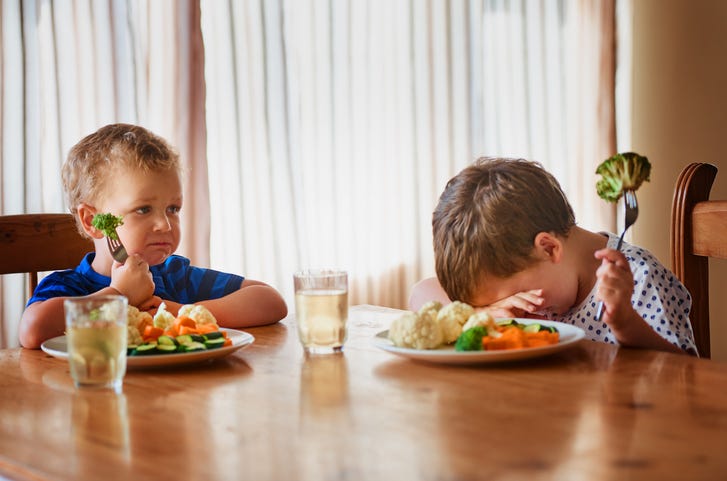


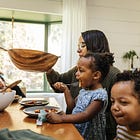
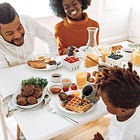






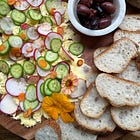
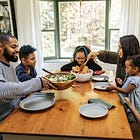

After a cross country move, my husband and I moved in with my Dad last fall. I no longer plan or cook most of the meals for my family! My Dad plans, shops, and cooks for all of us roughly 4 - 5x/week. It's amazing! My husband eats out most days at work and is actually pretty grumpy about grocery shopping, it's been hard moving on from the amazing grocery stores we loved back in Texas (HEB!). But we still shop for ourselves and I just buy what I want and eat what I want. Once a week my husband and I go out to eat and we do our own thing on most weekend days. My Mom is returning after a contract job out of the state and I'm low key nervous about her more demanding food preferences & that she'll maybe want to switch up tihs great formula! For fun, my Dad and I buy each other foods we know the other loves (Pop Tarts!) and geek out over food prices and new snacks/drinks we come across.
Just a perk of living in an intergenerational household that I did not expect.
Virginia, this quote "...the “end” is a non-picky child who eats all their vegetables—not because you pressured but because they learned to love them organically over time. This is like hoping intuitive eating will make you effortlessly thin. That’s just not going to be every kid." OH MY GOSH have you been stalking me for the last 17 or so years???
I realized I had some disordered eating, turned to intuitive eating, but at first it was very much through the Geneen Roth lens, and I was absolutely, completely sure that when I got intuitive eating "right," I would become thin. Effortlessly. Naturally. No, I did not.
Cut to several years later and I am a mom and I did the exact same thing with DOR. Not the thin thing, the thinking my child would be become a perfect eater who loved all foods, effortlessly! No, she did not.
Thankfully, I seem to be following the path many here and I am releasing so many expectations and obligations. This week when I grocery shopped I bought a bunch of frozen stuff because I am tired of being in charge and making all the choices and chopping vegetables. Last night for dinner my husband and I ate frozen spinach pizzas and my daughter had some cheese sticks and a maple flavored yogurt and a waffle and some mango. We're at the table together, we're all eating food, it's good enough.